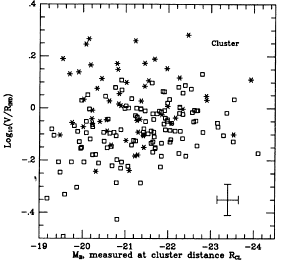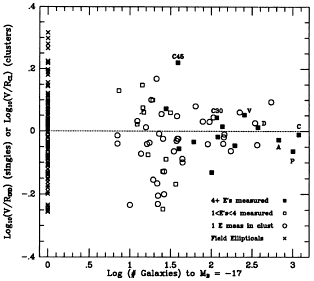


10.3.2 Possible Systematic Effects
Here we discuss the physical effects that could
systematically bias the method rather than systematic effects in the
data which are covered in Sec. 10.5.
A thorough discussion of possible systematic effects is presented
in the Appendix to BFD where they investigate the dependence of the
Dn- relation
on absolute magnitude, mass-to-light ratio and cluster
properties. They found no significant effects; their plot of
residual radial velocity vs. galaxy absolute magnitude is
reproduced in Figure 23. Mass-to-light ratio
and cluster effects are discussed below.
relation
on absolute magnitude, mass-to-light ratio and cluster
properties. They found no significant effects; their plot of
residual radial velocity vs. galaxy absolute magnitude is
reproduced in Figure 23. Mass-to-light ratio
and cluster effects are discussed below.

Figure 23. The logarithm of the ratio of predicted distance
corrected for Malmquist bias, to radial velocity in the cosmic microwave
background frame, log10(V/R), as a function of
absolute B magnitude of 182 galaxies in clusters, taken from
BFD. Galaxies from both the 7S sample (open squares) and BFD (stars) are
included.
|
The constraints on M/L implied by the existence of the
fundamental plane led
Silk (1989)
to suggest that the environments of ellipticals
might act to modify M/L and thus cause the zero-point of
the Dn- relation to vary within a cluster or
between clusters. Silk proposed that such an effect might introduce
spurious large scale motions.
This possibility has been tested by
Lucey et al. (1991b)
who found
no significant systematic dependence on the zero-point of
the relation over a factor of
150 in projected local galaxy density in the Coma cluster.
Similarly BFD found no dependence of the peculiar velocity
of cluster ellipticals
on M/L (as characterized by the strength of the Mg2 index
of the stellar population at a given
relation to vary within a cluster or
between clusters. Silk proposed that such an effect might introduce
spurious large scale motions.
This possibility has been tested by
Lucey et al. (1991b)
who found
no significant systematic dependence on the zero-point of
the relation over a factor of
150 in projected local galaxy density in the Coma cluster.
Similarly BFD found no dependence of the peculiar velocity
of cluster ellipticals
on M/L (as characterized by the strength of the Mg2 index
of the stellar population at a given  ). There are hints in BFD that
in a minority of field and group ellipticals the global parameters,
in particular line strengths, might be altered by the presence of
an intermediate age population.
Schweizer et
al. (1990),
noted that the presence of fine
morphological structures (jets, shells, isophote distortions)
also loosely correlate with indicators of the age of the stellar population
such that galaxies exhibiting fine structure appear to have a younger
component which they suggest was formed at the same time as the event
that generated the structure.
Gregg (1992)
has taken this further and demonstrated that those few
galaxies with the most marked morphological peculiarities
have systematically positive peculiar motions.
While the number of affected galaxies appears to be very small,
the effect of these
correlations on the application of the Dn-
). There are hints in BFD that
in a minority of field and group ellipticals the global parameters,
in particular line strengths, might be altered by the presence of
an intermediate age population.
Schweizer et
al. (1990),
noted that the presence of fine
morphological structures (jets, shells, isophote distortions)
also loosely correlate with indicators of the age of the stellar population
such that galaxies exhibiting fine structure appear to have a younger
component which they suggest was formed at the same time as the event
that generated the structure.
Gregg (1992)
has taken this further and demonstrated that those few
galaxies with the most marked morphological peculiarities
have systematically positive peculiar motions.
While the number of affected galaxies appears to be very small,
the effect of these
correlations on the application of the Dn- method needs
to be evaluated further.
method needs
to be evaluated further.
Djorgovski et
al. (1988)
investigated the possibility that
cluster properties such as richness, velocity dispersion, and density
might affect the form of the Dn- relation. They tentatively
suggested that cluster richness caused a variation in the slope and intercept
of the relation within clusters, possibly due to the effects of interactions.
However, these effects were not confirmed by BFD (see
Figure 24) and are
not present in the detailed study of the Coma cluster
by
Lucey et al. (1991b).
relation. They tentatively
suggested that cluster richness caused a variation in the slope and intercept
of the relation within clusters, possibly due to the effects of interactions.
However, these effects were not confirmed by BFD (see
Figure 24) and are
not present in the detailed study of the Coma cluster
by
Lucey et al. (1991b).

Figure 24. Ordinate as Figure 23 shown
as a function of the number of galaxies in a cluster with
MB < -17 (from BFD). The number of ellipticals in each
cluster is indicated. Field galaxies are included at richness 1. The
following clusters are identified: Virgo (V), Perseus (P), Coma (C),
Abell 1367 (A), Cen 45 (C45), and Cen 30 (C30).
|
The overall agreement of other
distance indicators with Dn- (see
Sec. 11) tends to confirm that
environmental effects are not generating mythical large scale flows.
Indeed, a remarkable set of coincidences
would be needed to explain the large scale pattern of peculiar motions
in terms of small M/L changes.
This is not to say, however, that there
are no clusters where the distance determined by
Dn-
(see
Sec. 11) tends to confirm that
environmental effects are not generating mythical large scale flows.
Indeed, a remarkable set of coincidences
would be needed to explain the large scale pattern of peculiar motions
in terms of small M/L changes.
This is not to say, however, that there
are no clusters where the distance determined by
Dn- is
discrepant with that of another method.
The most serious case is Abell 2634, where
Aaronson et
al. (1986)
find the cluster to be
at rest with respect to the Hubble flow, and
Lucey et al. (1991a),
using a DV-
is
discrepant with that of another method.
The most serious case is Abell 2634, where
Aaronson et
al. (1986)
find the cluster to be
at rest with respect to the Hubble flow, and
Lucey et al. (1991a),
using a DV- relation (based on V band photometry rather than
B band observations), find a peculiar velocity of > +3000 km
s-1. Such discrepancies need to be resolved.
relation (based on V band photometry rather than
B band observations), find a peculiar velocity of > +3000 km
s-1. Such discrepancies need to be resolved.
On balance it seems that environmental effects
have not been shown to bias Dn- as a standard candle but the
absence of a detailed physical model to describe the method demands
continuing care to ensure that such systematic effects do not enter into the
future application of the method.
as a standard candle but the
absence of a detailed physical model to describe the method demands
continuing care to ensure that such systematic effects do not enter into the
future application of the method.



 relation
on absolute magnitude, mass-to-light ratio and cluster
properties. They found no significant effects; their plot of
residual radial velocity vs. galaxy absolute magnitude is
reproduced in Figure 23. Mass-to-light ratio
and cluster effects are discussed below.
relation
on absolute magnitude, mass-to-light ratio and cluster
properties. They found no significant effects; their plot of
residual radial velocity vs. galaxy absolute magnitude is
reproduced in Figure 23. Mass-to-light ratio
and cluster effects are discussed below.




